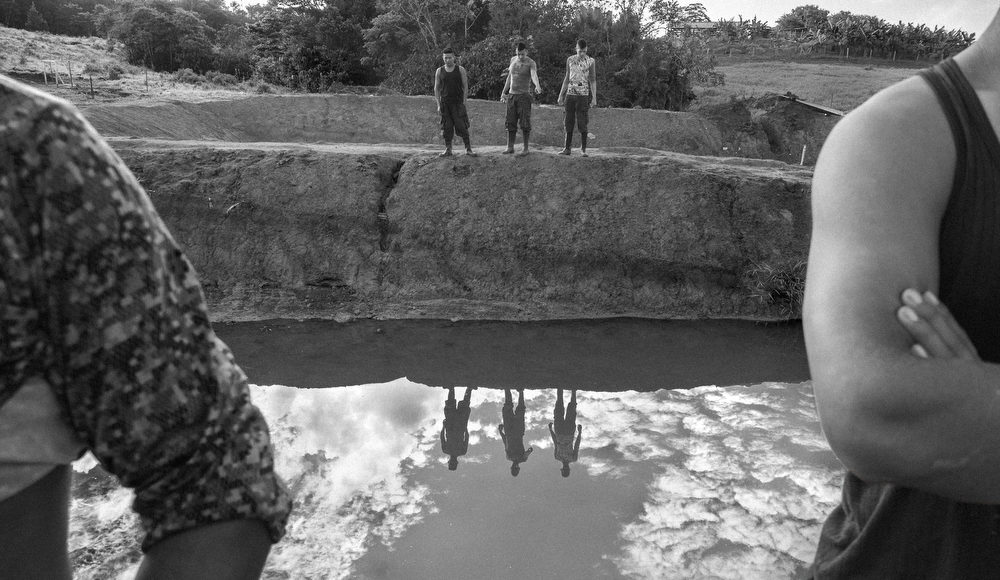Click an image in the slider, above, to view full-size.
In 2016 one of the world’s oldest, largest and best known guerrilla armies, the Revolutionary Armed Forces of Colombia, FARC, signed a peace treaty after more than half a century of brutal civil war. In June of that year, shortly before the government declared a ceasefire with guerrillas, I started work on a photo project about the FARC that will be published as a book in Colombia in June 2019 with the title Metamorphosis: Guerrilleros en Busca de la Paz/Guerrillas In Search Of Peace. It is the source of all the photos that accompany this story.
Without defending or romanticizing the guerrillas, Metamorphosis reveals them as people with the same emotions, hopes and fears as most other Colombians — very different from the sub-human “monsters” described for decades by much of the country’s media. The book is bound to spark controversy in Colombia as the new government of President Ivan Duque is pushing to undo the peace treaty and return to military confrontation.
Starting in early 2106, I tried for months to make contact with the FARC in Colombia’s capital, Bogota, and when nothing worked I went to Havana, where the peace talks were in progress. I spent a week in the coffee bar of the conference center and every time a FARC delegate appeared I introduced myself and described what I wanted to produce – a candid look at the FARC’s rank-and-file fighters showing who they were, how they felt about the peace process, and what would happen to them as it progressed. After a month or so I got a message to say my request to visit a camp had been approved, and in mid-June I took an all-night bus south from Bogota then a jeep into the jungle.
I planned to spend three weeks at the camp so I decided to take no photos for the first few days to give the guerrillas a chance to relax and ignore me when I did start shooting. I set nothing up and usually lowered my camera when anyone looked at me. The guerrillas were friendly, interested in the project, and unafraid of showing their faces. I followed many of the same people for the next two years. I visited them at other camps and family homes, and the passage of time consolidated those relationships.
A mood of optimism among the guerrillas gained momentum as the weeks unfolded towards their final conference at the end of September 2016 in the jungle hamlet of El Diamante in Caquetá state. Some remained skeptical but for many the euphoria was irresistible – only to be dashed a few days later when Colombian voters narrowly rejected the peace treaty in a plebiscite.
The peace process lurched towards collapse but, with pressure from its supporters inside Colombia and abroad, righted itself, and the agreement was re-worked. In 2017 the guerrillas began their complex journey to civilian life, moving to protected transition zones throughout the country over the next few months.
One evening in one of the transition zones I fell into conversation with a peasant who had just finished milking his cows and was tying the churns to his horse. He nodded toward a group of guerrillas and gave me a sideways smile. “Now they’re all angels, of course, but it wasn’t always like that,” he said.
As my book went to press, the government has been attacking the peace process in line with the far right policies of President Duque’s political patron, former President Alvaro Uribe. Violence is on the rise, with hundreds of killings of social leaders and former guerrillas since the change of administration. Many ex-FARC fighters have returned to the jungle to join dissident groups, not out of choice but as a way to survive what the government insists is not a coordinated campaign against them.
My book does not offer a comprehensive account of Colombia’s civil war or the FARC, and even the story I tell about the peace process has gaps. For example, after the plebiscite in 2016, I made the same mistake as many otherS, believing that Colombians would ratify the treaty. I returned home from the jungle before the No vote came in and, as a result, did not witness the reactions of grief, disappointment and near-despair that it provoked among the guerrillas.
On the other hand, stories are seldom complete. It was never my intention to photograph the same notionally significant events as the mainstream media. The images in Metamorphosis reflect changing states of mind or capture spontaneous emotions that are less predictable but, arguably, more authentic.
While the book is journalistic because it depicts a real situation, it also has a metaphorical dimension. The photos are not only about historical events but psychological responses to them; the sequence is broadly chronological but not rigidly so, to allow the images to challenge each other and provoke questions. My aim was to get away from the polarized view that has often led Colombians to defend opposing clichés and slogans instead of a searching for a deeper understanding of the conflict.
Metamorphosis will likely face a hostile reception in Colombia from opponents of the peace process because it does not present the same persistently negative view of the guerrillas that has been a feature of national (and much international) media coverage. Early in the project I came to believe that to get the photos seen by the public a book could offer a much more efficient vehicle than newspapers or magazines The response to Metamorphosis in the coming months will show whether, in Colombia’s increasingly repressive political environment, paper pages between hard covers represent a more open, more nuanced journalistic channel than higher-tech, mass media.
Guerrilleros en Busca de la Paz/Guerrillas in Search of Peace is published by Villegas Editores, ISBN 978-958-8818-68-9. Launch, pricing and ordering details will be published here soon.



